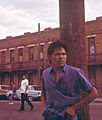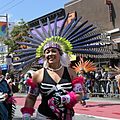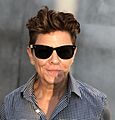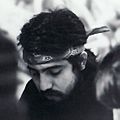Chicano facts for kids
A Chicano is a person who has family roots and/or citizenship in both the United States and Mexico. Often, the terms Chicano and Mexican-American are used to mean the same thing. Sometimes, people from Central or South America who live in the United States might also be called Chicano. The word Chicana is used for females. Chicanos often speak a mix of Spanish and English called Spanglish.
Who Are Chicanos?
Chicanos are people with a unique cultural identity that blends Mexican and American traditions. This identity often comes from their families having lived in areas that were once part of Mexico but later became part of the United States. It's a way of celebrating their heritage and their place in American society.
Chicano Culture and Identity
Chicano culture is rich and diverse, combining elements from both Mexican and American ways of life. It includes:
- Language: Many Chicanos speak Spanglish, which is a mix of Spanish and English.
- Art: Chicano art often features murals, paintings, and sculptures that tell stories about their history, struggles, and hopes.
- Music: Chicano music blends traditional Mexican sounds with American genres like rock, jazz, and hip-hop.
- Literature: Chicano writers explore themes of identity, family, and social justice in their books and poems.
- Community: Strong community ties and family values are very important in Chicano culture.
Notable Chicanos
Many Chicanos have become famous and made important contributions in different areas like arts, culture, sports, technology, and politics. Here are a few examples:
- Gloria E. Anzaldúa, a well-known author and scholar.
- Ana Castillo, an author whose books often explore the lives of Mexican-American women.
- Sandra Cisneros, a famous author known for her book The House on Mango Street.
- George Lopez, a popular comedian and actor.
- Lynda Carter, an actress famous for playing Wonder Woman.
- Rudolfo Anaya, a novelist considered one of the founders of Chicano literature.
Images for kids
-
The Chicano Movement often focused on men, which led to Chicana feminists asking for more equal roles for women.
-
A man in San Antonio, Texas with a tattoo of the word Chicano. Photo by Jesse Acosta
-
Xiuhcoatl Danza Azteca performing at the San Francisco Carnaval Grand Parade in Mission District.
-
Gloria E. Anzaldúa believed in using spiritual ideas to create social change.
-
Rudolfo Anaya (1937-2020) was a very important writer in Chicano literature.
-
An illustration of Selena, showing a mix of Mexican and American flags in the background.
-
Murals at Estrada Courts
-
The Arch of Dignity, Equality, and Justice by Judy Baca at San José State University
See also
 In Spanish: Chicano para niños
In Spanish: Chicano para niños





















